Paintball markers are the backbone of the sport. They are often referred to as paintball guns, but regardless of what you call them, they provide a safe and exciting way of playing the game. From entry-level beginner options to advanced tournament-grade markers, they come in all shapes, sizes and price points. In this comprehensive guide, we will discuss everything you need to know about paintball markers including features, safety considerations and more.
Paintball Marker vs Gun: What is a Paintball Marker?
Paintball markers, sometimes referred to as paintball guns, are the equipment used in the sport of paintball. Paint markers are designed to fire a rubber-shelled gelatin capsule filled with non-toxic water-soluble dye and powered by compressed air. The capsule breaks on impact, releasing the dye which marks the target.
Paintball markers differ from traditional firearms in several ways: most notably they fire a much smaller projectile than guns do; ammunition is different; and special safety gear must be worn when playing paintball. Paintball markers also have low power compared to a gun. This makes them generally safe for recreational use.
Paintball markers come in many shapes, sizes and prices. They range from entry-level models costing around $50 all the way up to custom high-end models that cost over $1000. There are also markers designed specifically for woodsball (playing outdoors) or speedball (playing indoors), as well as option parts such as triggers, barrels and stocks that can be swapped out to modify performance or customize look.

What are the Parts of a Paintball Marker?
Once you know what is a paintball marker, it is also important to know the different parts of one. All paintball markers have five main components, each with its own purpose and function:
- Marker Body – The body of the paintball marker houses all of the other components and connects them together. It offers protection from impact, dust and water so you can take your marker into any environment without worry.
- Barrel – This steel or aluminum piece determines the accuracy of your shots. It is where the air pressure propels the balls through for shooting. A good barrel will offer more control and accuracy over longer distances.
- Hopper/Loader – Also known as a magazine or box mag, the hopper is responsible for feeding ammunition into your marker. The hopper holds up to 200 rounds of paintballs and is mounted onto the top of the marker.
- Trigger – This part is what you will be using when shooting your paintballs. The trigger releases the air from the chamber that propels the balls out of the barrel.
- Air/Gas Tank – Last but not least, each paintball marker needs an air or gas tank to work properly. This tank contains either air or C02 and it’s what gives power to your shots by releasing a burst of air pressure each time you shoot. [1]
Knowing these parts can help you better understand how paintball markers work and make informed decisions when it comes to upgrading or maintaining your marker. That’s why it’s important to be familiar with the different components that make up a paintball marker before taking it out on the field.
Gun/Body
The body of a paintball marker, commonly referred to as the gun, is where all the action takes place. It is usually made of durable materials such as aluminum, plastic or composite and houses all the necessary parts that make up the marker. The gun’s body can be customized with different attachments such as sights, stocks and fore grips for added comfort and accuracy. Additionally, many aftermarket barrels are available to further enhance performance and accuracy.
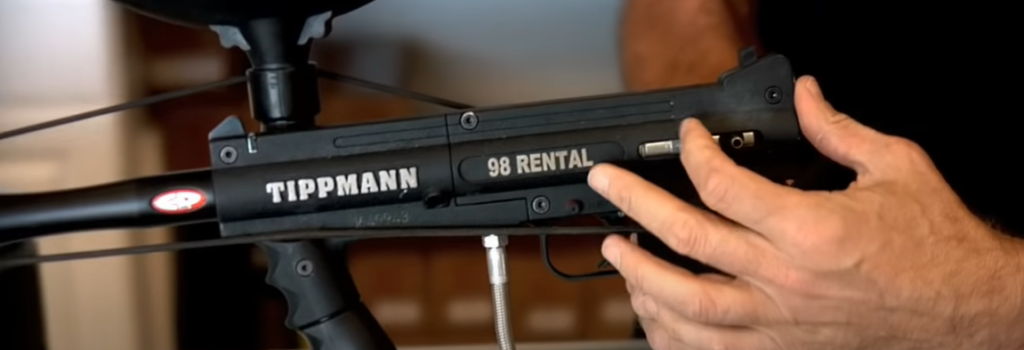
Loader
The loader is an important component of the paintball marker. It’s responsible for loading and feeding the gun with paintballs. There are two common types of loaders: gravity-fed and motorized hoppers. Gravity-fed loaders draw fresh paintballs into the chamber as they shoot out, while motorized hoppers spin rapidly to keep up a steady stream of ammunition ready to fire. Choosing one that fits your style is key! Generally speaking, more serious players tend to purchase motorized hoppers as they provide a faster rate of fire and reduce the possibility of jamming or misfiring due to lack of ammunition in the chamber. However, gravity fed loaders are easier to maintain, cheaper and less obtrusive – making them the most popular choice for recreational players.
No matter which type of loader you choose, make sure to check that your paintball marker is compatible before buying. You’ll also want to consider whether or not you need additional accessories such as a hopper lid or an adapter if your gun doesn’t feature a built-in feedneck. Once you’ve got all the right components, it’s time to fire off some rounds and have fun!
Barrel
A paintball marker barrel is an important and necessary part of a paintball gun. The longer the barrel, the more accurate it will have. Paintball barrels come in different lengths and widths so you can find one that suits your needs. A shorter barrel may be better for close-range combat, while a longer barrel might be better if you are playing on a larger field and need greater accuracy. Barrels also come in different materials like aluminum, carbon fiber, stainless steel and brass. Make sure to choose a material that won’t affect the performance of your paintball gun negatively.
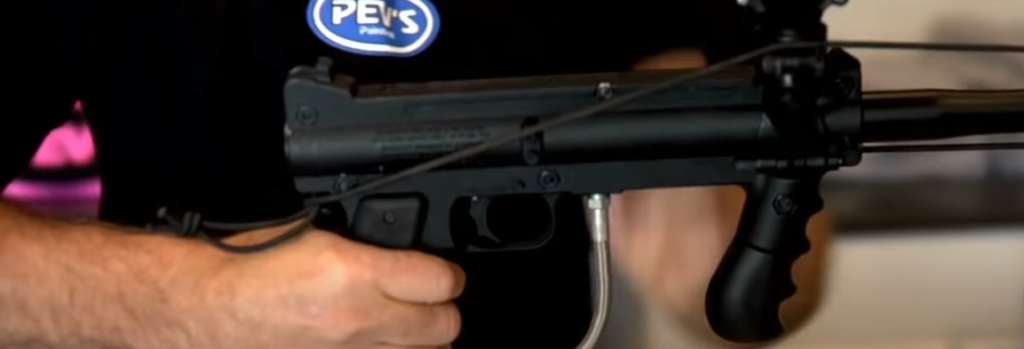
Air Tank
The air tank on a paintball marker is the component that stores compressed air or CO2 and powers the gun. The size of the air tanks ranges from 2-24 ounces, depending on individual preferences. Air tanks come in different shapes and sizes, but all have one thing in common – they store your source of compressed air in order to fire your shots. There are two types of materials for air tanks: aluminum and carbon fiber. Aluminum tends to be cheaper, lighter and more durable whereas carbon fiber is more expensive but also stronger, providing a longer life span for the tank. Some newer models may even feature an adjustable regulator which allows you to adjust the pressure of your shots accordingly. [2]
Paintball Marker Differences
In the world of paintball, there is a variety of markers available for players to use. Each type has its own distinct advantages and disadvantages, making it important to understand which one will be the best fit for you. Here’s a quick look at some of the different types:
- Mechanical Markers: These are the classic paintball guns that have been around since the early days of paintball. They are powered by compressed air tanks that can be filled with CO2 or High Pressure Air (HPA). These markers require a bit more maintenance than other types, but they offer an authentic feel and good accuracy.
- Electronic Markers: Often referred to as E-Markers, these modern guns feature electronics that allow them to fire rapidly and accurately. They are powered by rechargeable batteries, and their firing speed is typically adjustable for different types of play.
- Pump Markers: These markers are manually operated, meaning you have to cock the gun with each shot. As a result, they can be slower than other types of markers but offer an advantage when it comes to accuracy. They require minimal maintenance and are perfect for those just getting into paintball.
Now that you know a bit more about the different types of paintball markers available, it’s time to find the one that best suits your needs! No matter which type you choose, make sure you read up on safety rules before entering any game — it’s always important to keep safety a priority.
Basic Types of Markers
Paintball markers come in a wide variety of designs and sizes, but they all work according to the same basic principles. A paintball marker consists of a hopper that holds the paintballs, a barrel and breech or feedneck where the paintballs are loaded into the firing chamber, an air source that propels the paintballs through the barrel, and a trigger assembly. The most common type of air source used with paintball markers is compressed air tanks or CO2 cartridges.
The two main categories of markers are pump action and semi-automatic. Pump action markers require the user to manually prime the marker between each shot by pumping it like a shotgun. Semi-automatic markers use springs to reload each shot automatically after the trigger is pulled. Pump action markers are usually more accurate but slower to fire than semi-automatic markers.
Most modern paintball markers also feature some sort of electronic firing system, such as an Electronic Control Circuit (ECC) or Programmable Firing System (PFS). These systems allow the user to program various firing modes, such as full-auto and three-round burst, into their marker making it easier to control their rate of fire.
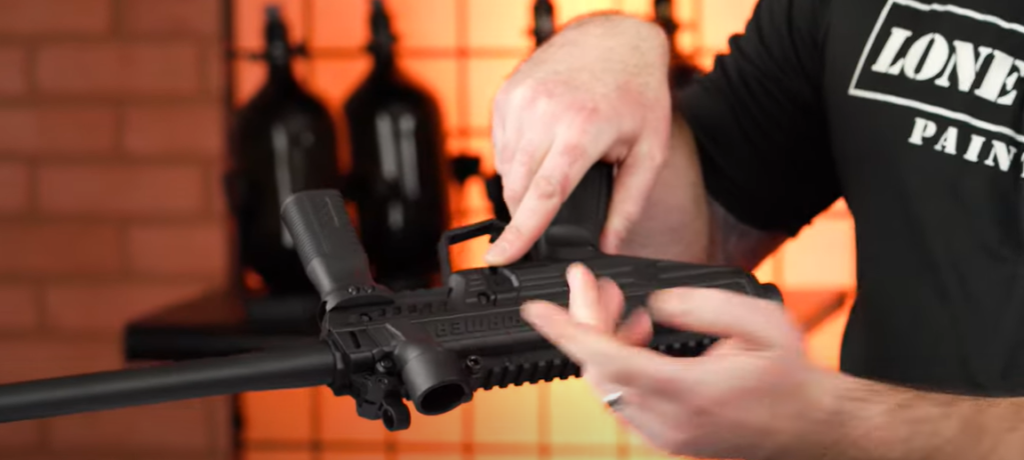
Pump paintball markers
Pump paintball markers provide a unique experience in the world of paintball. These markers require manual loading and cocking before each shot, making them a favorite among experienced players who prefer more traditional shooting mechanics. Pump guns are also much quieter than their electronic counterparts, and can be used for scenarios where you want to maintain an element of stealth. They tend to have less firepower than other types of markers but offer an exciting challenge for players looking for something a little different. There are some great options available if you’re interested in exploring this classic type of marker!
Mechanical paintball markers
Mechanical paintball markers are the most basic type of marker and are operated by mechanical means. They fire one shot for each trigger pull, which is why they are also referred to as “pump” paintball markers. Mechanical markers require manual cocking before each shot can be fired and can be powered by a CO2 or HPA compressed air tank. Some mechanical markers come with built-in hoppers, although this isn’t always the case.
The advantage of using a mechanical paintball marker is that it requires very little maintenance compared to electronic versions. It’s also much easier (and cheaper) to learn how to operate one since there aren’t any complex electronics involved. On the downside however, mechanical models usually have lower firing rates and less accuracy than their electronic counterparts.
Electronic paintball markers
Electronic paintball markers are the latest technology used in paintball guns. These markers use an electronic trigger, a drop-down hopper, and an onboard computer system to provide greater accuracy and firepower than traditional paintball markers. They also require extra maintenance and care due to the complexity of their parts. Some electronic paintball markers will allow you to adjust the velocity of your shots as well as set different firing modes such as semi or full auto fire. Electronic markers are typically more expensive than their mechanical counterparts, but they offer many advantages that make them worth the cost. [3]
Additional Tips
Now that you know the basics of what a paintball marker is, here are some additional tips to help make sure you get the most out of your experience:
- Check local laws and regulations. Different states have different restrictions on how powerful a paintball gun can be, so it’s important to look into any specific rules in your area before you purchase one.
- Choose the right size barrel. The longer the barrel on your marker, the more accurate and consistent your shots will be. However, too long of a barrel will decrease maneuverability when playing in tight spaces. Consider getting an adjustable barrel or test-firing different sizes before purchasing one.
- Clean and lubricate regularly. Paintball markers require regular maintenance to keep them in the best condition. If you’re shooting a mechanical marker, it’s especially important to ensure that all components are properly lubricated and functioning correctly.
- Wear protective gear. As with any sport, paintball has some inherent risks and can cause injury if proper protective gear isn’t worn. Make sure you have a reliable set of goggles, face mask, and clothing that covers your arms and legs to ensure your safety while playing.
Following these tips will help make sure you get the most out of your paintball experience and stay safe at the same time!
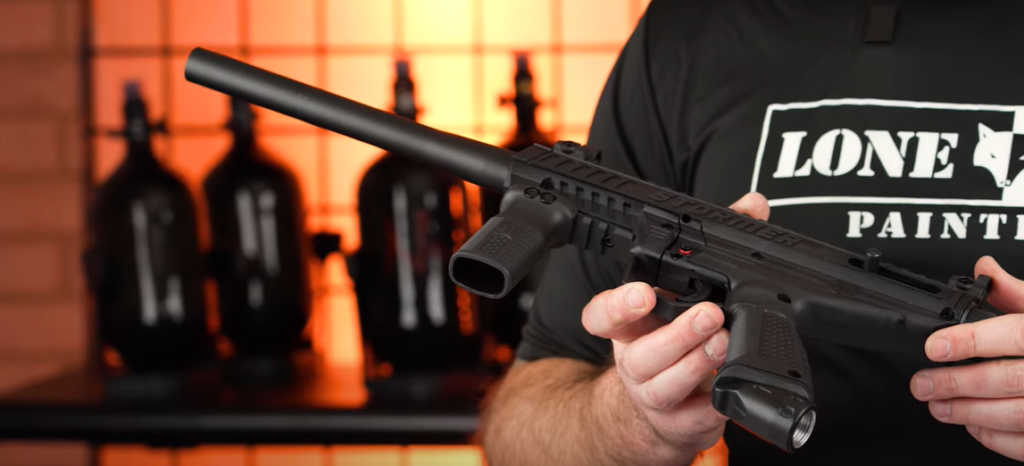
FAQ
What does a paintball marker do?
A paintball marker shoots round, gelatin capsules filled with a water-soluble dye. It is designed to be used in the game of paintball which involves two or more players using their markers to shoot each other and eliminate one another from play. The markers use compressed air or carbon dioxide (CO2) as a propellant to fire the capsules at high speeds. [4]
What is the difference between a paintball gun and a paintball marker?
A paintball gun and a paintball marker are actually the same types of equipment, with the only difference being in the name. Paintball guns shoot round plastic balls filled with paint that are used in a recreational sport called “paintball”. The sport is much like a game of tag or hide-and-seek, but players use paintballs instead of hands to mark each other out.
Paintball markers, on the other hand, refer to the device used to fire these paintballs. They look like real firearms (with some distinct differences) and come in all shapes and sizes depending on their purpose. Some markers have specialized features such as electronic trigger systems while others may feature adjustable air regulators for more precise shots.
No matter what type of marker you use, it is important to remember that a paintball gun and marker are two different names for the same piece of equipment. Both terms are interchangeable, so don’t worry about getting confused! As long as you have a device capable of firing paintballs, your friends will know exactly what you’re talking about. So go ahead, grab your gear and get ready to play some paintball!
Why are paintball guns called markers?
The name ‘marker’ is commonly used to describe a paintball gun, because the primary purpose of the gun is to mark trees that were to be cut down. The term “marker” was first used when paintball games were played in fields and players needed an efficient way to mark their opponents and keep track of who they eliminated or tagged out during gameplay. [5]
When playing recreationally, markers are usually semi-automatic or mechanical guns that shoot small balls filled with water-soluble dye at high speeds, which allow participants to safely compete against each other and even hide behind obstacles while strategically planning their next move. They are also highly customizable and often come in various sizes, colors, shapes, materials, and models designed for different game types and playing styles.
Ultimately, paintball markers are a great way to bring excitement to your next outdoor adventure while providing a safe, fun way to compete against others. Whether you’re an experienced player or just getting started, understanding the basics of how markers work can help you get the most out of your paintball experience.
What is in a paintball?
A paintball is a small plastic capsule filled with water-soluble, non-toxic paint. Paintballs come in different sizes and colors and can be used for different types of play. The most common type of paintball is the .68 caliber size, but there are other sizes available such as .50 caliber and .43 caliber.
The term “marker” refers to any device or tool that shoots or propels a projectile, including a gun as well as a paintball marker. A paintball marker, also known as a paintball gun, is specifically designed to fire projectiles filled with dye or colorant at another player during an organized game of paintball. Paintball markers usually use gas propellants such as CO2 or compressed air to fire the paintball.
A paintball marker typically consists of a barrel, an operating mechanism such as a trigger, a gas reservoir and nozzle for propelling the paint, and various other parts like hoppers and feeders that help load and fire the balls. Paintball markers come in many shapes and sizes depending on their intended use — from sleekly designed tournament-style markers to classic military replica models.
Whether you’re playing in an organized game of woodsball or just want to try out the sport at home, understanding what is in a paintball marker is important to ensure everyone’s safety while they play. Understanding how these tools work can also help you choose the right type of paintball marker for your needs. Regardless of what type of paintball marker you choose, proper safety gear is always recommended when playing.
Now that you know the basics about what is in a paintball marker, you can decide which type is best for your game or setup. There are plenty of options available to suit any budget and playing style — so get out there and start shooting! Have fun and stay safe on the field.
Useful Video: How to Use a Paintball Gun aka Marker | Paintball
Conclusion
Paintball markers are excellent tools for getting involved in the exciting sport of paintball. They come in a wide range of sizes, shapes, and styles to suit your individual needs, preferences, and budget. Some markers are designed for speedball or tournament play while others may be better suited to recreational or woodsball games. It is important to familiarize yourself with different types of markers before making a purchase so you can make an informed decision on which marker will best meet your needs. With proper maintenance and care, a paintball marker should last many years of enjoyable use. Enjoy the game!
References:
- https://www.paintballusa.org/blog/paintball-marker-differences
- https://gungiveaways.com/what-is-a-paintball-marker/
- https://paintballnest.com/types-of-paintball-guns/
- https://en.wikipedia.org/wiki/Paintball_marker
- https://hobbystrategy.com/why-are-paintball-guns-called-markers/


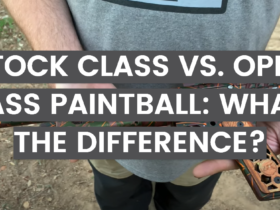





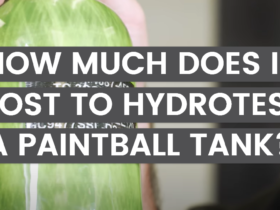
Leave a Review